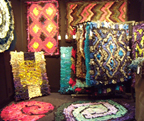If you want to design your own rug, it’s possible that I will be able to
- create a rug according to your own design,
- create a kit so that you can make your own rug according to your design,
- guide you to someone who can make exactly the rug you have in your mind.
I should point out, I am thinking about designing your own area rug in one of the hand made methods, such as knitting, crocheting, or weaving. If you are thinking of something room-size, you’ll need to search on “carpet design” and you’ll find plenty of companies across the price and size range that can help you.
The first step? Get out your crayons and play. Colored pencils, maker, Paint program; your drawing tool of choice Sketch the idea you have in mind. If you get stuck on details, look for suggestions in an interiors magazine and glue a paper-swatch in place.
If you can’t come up with one design, try thinking of 10. Some people get more stuck trying to design one perfect something, and asking them to do 10 gets them off “perfect.” Draw 10 shapes on your paper, small enough to put 10 area rug designs on the back of an 8 x 11 sheet of paper. Sketch.
While you’re sketching, think about the questions below:
20 Questions that will help you design your own rug:
(At the moment, I only have 12, but the list may grow…)
Would any of the rugs on this page work, “if only…” they were a little different… Bigger, smaller, color, shape?
- Yes: Contact me and let’s see if we can work out a plan to create a rug in your own design.
- No: Look at the rest of these questions:
Easy questions about designing a rug
What color story do you have in mind for the rug you’re designing?
You can design a rug in any color you want, and in any color combination, you want. Samples can be matched. Pet hair color can be matched, and therefore concealed… (After years of vacuuming black cat hair off a beige rug, a friend took her carpet to the shelter to pick out the new kitten that matched the rug.) Most-likely stains can be concealed in an area rug that won’t show any of the major shades of Kool-Aid.
How big will the rug in your design be?
The larger the rug, the sturdier its underlying structure needs to be. Handmade knit and crocheted rugs can go to about 4’ x 6’, but even then, they will stretch. Area rugs that are larger than 6’ in one dimension need an underlying structure such as non-stretching warp threads that provide support. This means some form of weaving. (Braided rugs may be an exception to this guideline.)
Do you have a shape in mind?
- Rectangular rugs, which includes square, can be made on a floor or tapestry loom.
- Round and oval rugs are often knit, crocheted, or braided.
- Rugs made on a canvas, such as hooked, needlepoint, or Rya, can be almost any shape you imagine.
Do you want to design a picture into your rug?
Rugs designed with a picture are generally made on a canvas backing or a tapestry loom. The y can be hooked, needlepointed, or hand-knotted, or made with a Rya stitch.
Knitting, crocheting, braiding, and floor looms can be used to make striped and solid color rugs, including some patterns and abstract designs created by color management.
How will you use the rug you are designing?
I tend to think in terms of a continuum of rug use and abuse roughly defined as, “how far away from the front door will the rug be used?” The farther away, the finer the materials and the less wear and tear. Unless it used in the kitchen or under the dining room table to keep spills off the wall-to-wall, a rug not near the front door does not need to be cleaned very often.
Harder questions
That said, How will you clean your rug?
In your own washing machine (front loader, ideally), in a large-capacity laundromat machine, in the carwash (don’t laugh, it works, as long as it’s warm enough for the rug to dry afterwards, perhaps on the deck) or by a professional cleaner, if necessary?
What’s your budget?
Custom-made rugs can run from $20 / SF to several hundreds of dollars per square foot. (Commercial carpeting is usually sold by the square yard—divide those prices by 9 to compare.)
Actual material costs are a relatively small part of the total investment; labor will be the bulk of the cost.
Do you plan to make the rug yourself?
If so, would you be more likely to complete the project if you acquired a kit, or will you make the rug you design from scratch?
Allowing between 3-5 hours per finished square foot (possibly much higher for hooked rugs; lower if you have a floor loom already warped), divide the cost of a kit by the number of hours of engagement it will provide. I usually allow that if the final “value per hour invested” is on the order of the cost of something else I would enjoy, such as going to a movie, I go ahead and buy the project parts.

